Earliest meeting: Thursday 8th September 1730
Final meeting: Thursday 4th May 1933
The Welsh market town of Monmouth, within two miles of the English border, is located where the Rivers Wye and Monnow meet. The town is steeped in history, being the site of the Roman fort of Blestium, and after the Norman invasion its famous Castle was built in 1067. The first record of racing taking place in the vicinity of the town was on Thursday 8th September 1730. It took place on Chippenham Meadow, on the banks of the River Wye, when the £30 Plate was won by Mr Middleton’s Infant. Racing ceased in 1777 but returned to the Chippenham course in 1810. At a two day meeting from Wednesday 6th to Thursday 7th October 1824 the Sweepstake was won by Cardinal Puff for Mr Pryse, while the Wrexham County Members Plate went to Mr Day’s Sloe. In 1836 Charity won a lowly hurdle race at the track and few would have realised that he was a future Grand National winner in the making. Indeed, the first Grand National winner Lottery won a 3 mile steeplechase at Monmouth in 1841, two years after landing the great race. However, it is more than likely that the course on which Lottery was successful was a cross-country steeplechase course rather than the usual racecourse. The main evidence for this is that the usual two day Autumn meeting, held on Tuesday 5th and Wednesday 6th October 1841, consisted of Flat races and one Hurdle race. The card on Tuesday 5th October opened with the Tredegar Stakes, twice round the course, in which Mr Gough’s Aimwell defeated Fat Jack and Prudence. The Hack Stakes followed which went to Mr Trotter’s Nell who got the better of Hesperus and Ploughboy. The next day the card opened with the Chippenham Stakes over 1 ½ miles, where Fat Jack gained revenge for his defeat the previous day, overcoming the challenge of bot Henley and Aimwell. The Free Handicap, twice round the course, was won in convincing style by Mr B Francis’s Victoria, at the main expense of Hesperus and Henley.
Thursday 8th September 1730
Monmouth £30 Plate
1. Infant owned by Mr Middleton
2. Peggy-grieves-me owned by Mr Neale
3. Moll Quickly owned by Sir J Dutton
4. Castaway owned by Sir W Morgan
Wednesday 6th October to Thursday 7th October 1824
Monmouth 5 Guineas Sweepstake over 2 miles and a furlong
1. Cardinal Puff owned by Mr Pryse
2. Melampus owned by Mr C Day
3. Wiseacre owned by Mr Goddard
Wrexham County Members Plate over 3 miles
1. Sloe owned by Mr Day
2. Presentiment owned by Mr Goddard
3. Dr Eady owned by Mr Pryse
Thursday 27th & Friday 28th September 1855
The Monnow Stakes over 1 ½ miles
1. Hothorpe owned by Mr T Olliver
2. Little Sambo owned by Mr Hylton
3. Eden owned by Mr Williams
Monmouth County Members Plate over a mile
1. Bright Phoebus owned by Mr Cartwright
2. Helene owned by Mr Lewis
3. Goldhill owned by Mr Haliford
The Troy Plate over 1 ½ miles
1. Phantom owned by Mr Orchard
2. Cardiff Lass owned by Mr Lewis
3. Susannah owned by Mr Thomas
The Wye Stakes over 7 furlongs
1. Cardiff Lass owned by Mr Lewis
2. Phillip owned by Mr G Drewe
3. Petticoat owned by Mr Lloyd
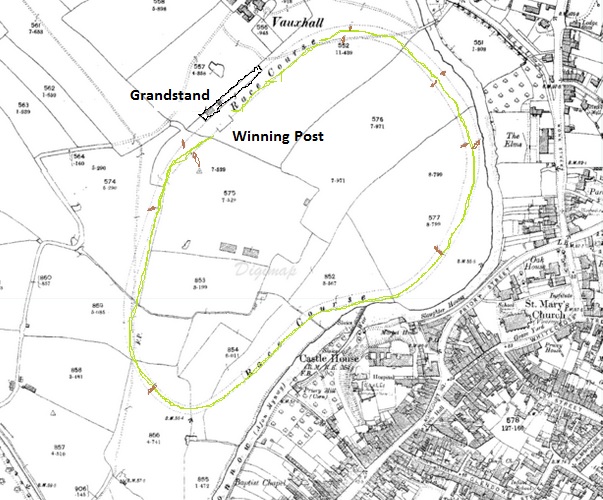
I am grateful to Peter Garwood for the 1888 Monmouth Races advertisement shown below:-

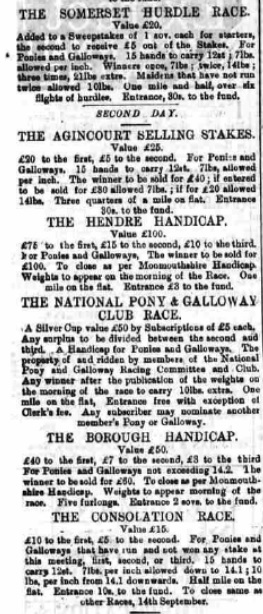
Although a meeting did take place on Thursday 24th September 1874 and Friday 24th September 1875, with results shown below, the two day meeting scheduled for Thursday 21st and Friday 22nd September 1876 on Chippenham Mead did not take place ‘because entries were insufficient and, numerically speaking, all but a failure. This marked the end of Flat racing in 1876 and with it the closure of the Chippenham course for thoroughbred racing. However, as Peter Garwood has pointed out opposite, races did continue, although they involved Pony Races and Galloway Races.
Thursday 24th September 1874
County Members’ Plate
1. Victoria Alexandra
2. Harefoot
3. Crumpetail
Beaufort Cup
1. Queenswood
2. Phoebe Athol
3. Blytheswood
Troy Plate
1. Kangaroo
2. Competitor
3. Harmony
Chippenham Stakes
1. Cranbourne
2. Victoria
3. Bothwell
Hendre Stakes
1. Austrey
2. Souvenir
3. Verity
Friday 24th September 1875
Lady’s Plate
1. Martini
2. St Helens
Drybridge Stakes
1. Simplicity
2. Portia
3. Sea Lawyer
Clytha Stakes
1. Patriot
2. Jasper
3. Avis
Monmouthshire Stakes
1. Englishman
2. Phoebe Athol
3. Devastation
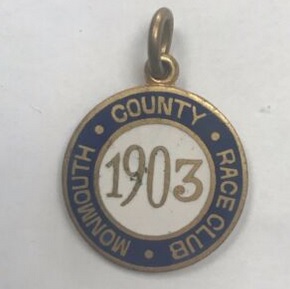
It seems incredible that a badge from the old racecourse still exists today and a copy is shown below:-
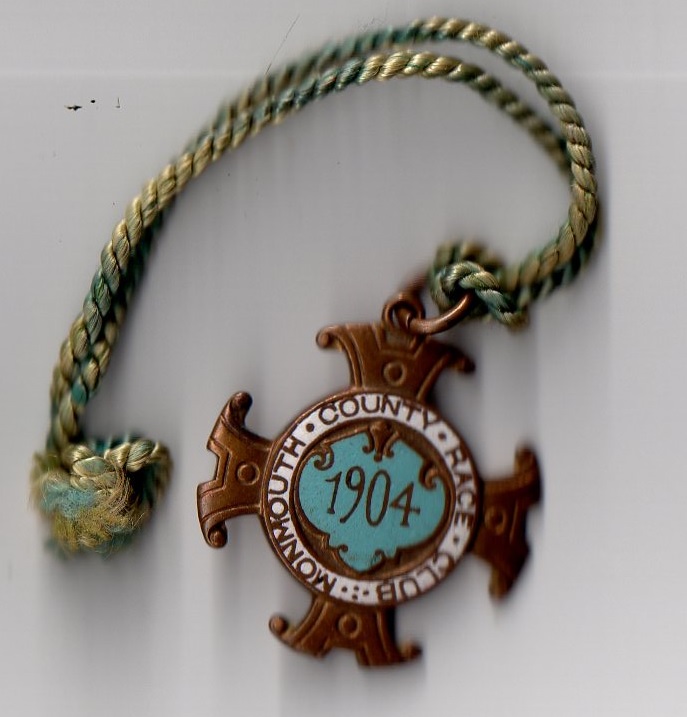
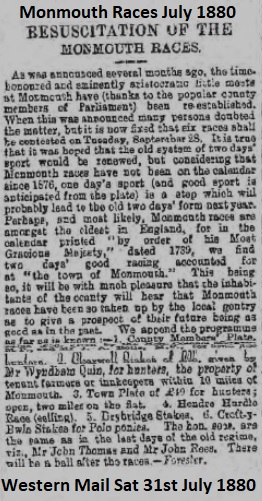
Monmouth Hunt National Hunt races first began on Tuesday 28th September 1880 when attention switched to Vauxhall Meadows. The meeting was attended by such dignitaries as Lord Raglan, Colonel Lindsay and Captain P Herbert, while the Chief Steward was Hon. Colonel F C Morgan. A large crowd and at least 15 four-hands lined the course to see the opening race, the County Members Plate, go to Mr H Owen’s Montgomery.
County Members Plate
1. Montgomery owned by Mr H Owen
2. Adam Gregor owned by Mr F Bowers
3. Blue Bonner owned by Mr A Taylor
4 ran
Clearwell Stakes
1. Aide-de-Camp owned by Mr Stoneman
2. Little Robin owned by Mr Little
3. Findon owned by Mr Humphries
Monmouth Town Plate
1. Marcia owned by Mr J Holman
2. Crambo owned by Mr Reg Herbert
3. Midsummer owned by Mr J A Rolls
Hendre Hurdle
1. Artificer owned by Mr H Cobden
2. Aide-de-Camp owned by Mr Stoneman
3. Princess owned by Mr W Quinn
Partridge Stakes
1. Crambo owned by Mr P Herbert
2. Storm King owned by Mr H Cobden
3. Blue Bonnet owned by Mr A J Taylor
Leading up to the First World War the March 1912 meeting had to be abandoned due to the national coal strike, and racing did not return until Wednesday 19th October 1921, the meeting on 6th and 7th April 1921 having been abandoned. There was fierce competition with nearby Chepstow once it opened for the first time in 1927 and, in the end, Monmouth lost that battle and held its final two day meeting on Wednesday 3rd and Thursday 4th May 1933.
I am grateful to Ordnance Survey (© Crown Copyright) for permission to use the map shown below.
.jpg)
I am grateful to Peter Garwood for the detailed map shown below. Note the position of the winning post and the grandstand.
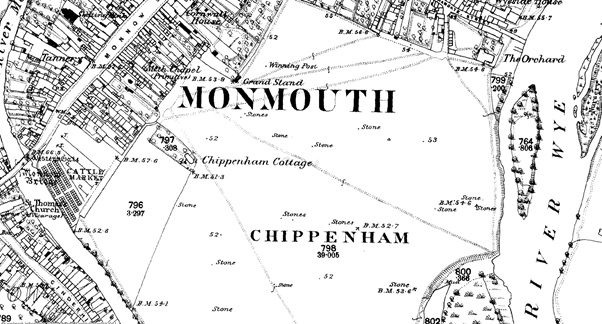
The Ordnance Survey maps shown below show the position of the racecourse relative to the town of Monmouth. The army made use of the racecourse during the First World War and the map from 1920 shows the position of the Army Barracks. Note also the Steeplechase course and the Hurdle course.
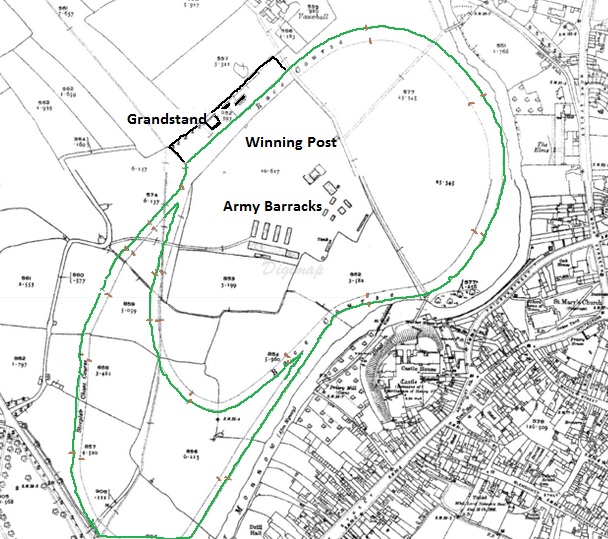
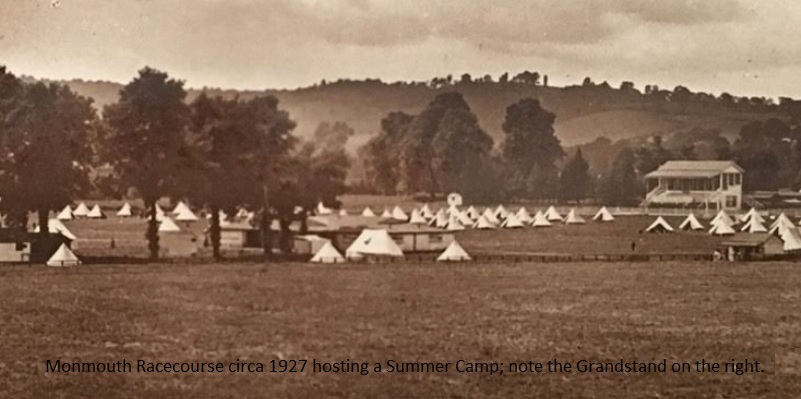
The final meeting took place on Thursday 4th May 1933.
2.10 Drybridge Selling Handicap over 2 miles
1. Wild Thyme (4/1) ridden by B Morgan
2. Ballykinler (4/1) ridden by Mr Wood
3. Apple Jack (5/1) ridden by Hamey
2.40 Monmouth Selling Chase over 2 miles
1. Cheviotdale (5/2) ridden by Mr Dennistoun
2. Jehu (4/7 fav) ridden by G Wilson
3. Jacob (5/1) ridden by Hamey
3.10 Monmouth Hunters’ Chase over 3 miles
1. Wales II (6/4) ridden by P Curtis
2. Miss Ellen (6/1) ridden by Mr H Kennard
3. Merville II (10/1) ridden by his owner
3.40 Chepstow Hurdle over 2 miles
1. Blaze (5/1) owned by Sir E Willis and ridden by Parvin
2. Santick (8/1) ridden by his owner
3. Prince Grosvenor (9/2) ridden by his owner
4.10 Club Handicap Steeplechase over 2 miles
1. More Magic (100/8) owned by Lord Stalbridge and ridden by Parvin
2. Dove’s Pride (5/2) ridden by Speck
3. Breconian (4/1) ridden by Mr Harry Llewellyn
This brought the curtain down on Monmouth races, but what was the impact on the town and the villages surrounding Monmouth? It was clearly an important contribution to the town of Monmouth; Horses were measured outside the King's Head, while Inns would have been full to capacity leading up to and on race days. Casual labour on the racecourse would have benefited locals with the setting up and taking down of tents and booths. Then there was the impact on nearby villages, like Trellech, where the residents were able to place bets with each other on the winners. Gambling was ubiquitous like cockfighting must have been in earlier times. This interest in racing and gambling expanded once the railways opened, an event that enabled more of the public to travel quite easily to enjoy racing at Monmouth. The closure of racing was an event that would have had an impact on the finances of Monmouth and district.
Course today
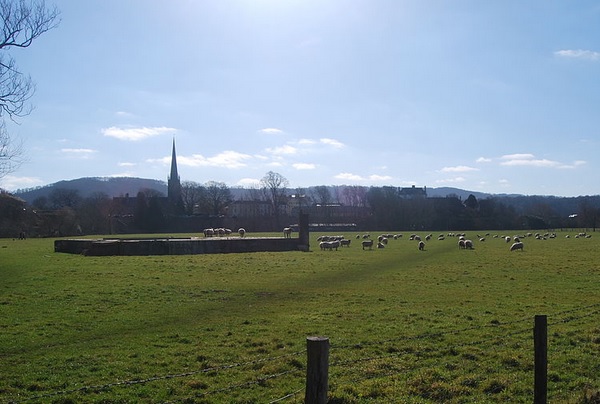
Much of the information about this course has been found using internet research and is in the public domain. However, useful research sources have been:-
London Illustrated News
Racing Illustrated 1895-1899
The Sporting & Dramatic Illustrated
Northern Turf History Volumes 1-4 by J.Fairfax-Blakeborough
The Sporting Magazine
A Long Time Gone by Chris Pitt first published in 1996 ISBN 0 900599 89 8
Racing Calendars which were first published in 1727



